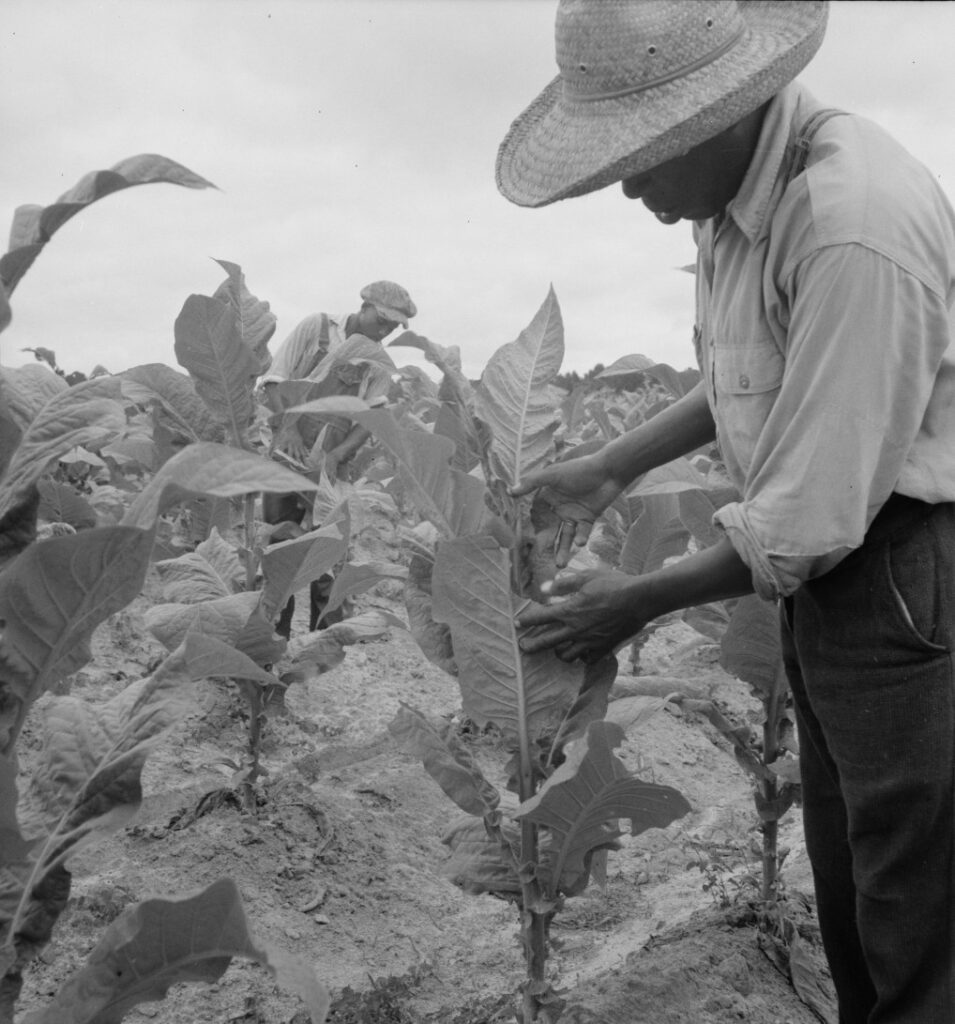
**This research was first published in the July 10, 2024 edition of the Chatham Star-Tribune newspaper as part of Kyle Griffith’s weekly segment entitled “Heritage Highlights.”

A man checking a tobacco crop for hornworms circa 1940. Photo courtesy of the Library of Congress.
Back in 1941, an interview was conducted with sharecropper Sam Harrison of Pittsylvania County. He opened up and provided a remarkable perspective of a life spent in the tobacco fields over a century ago. In addition, the interviewer, Roscoe Lewis, skillfully captured Sam’s old fashioned dialect as if the reader can still hear his voice. At the time of the interview, Sam was living over in Whaleyville, Virginia near to the Great Dismal Swamp. He and his wife Tildy raised six children together. Many details of his life, including his date of birth and the names of his parents, are unknown, but he was born sometime around 1890. A further search for this Harrison family in census records proved unsuccessful.
“I was brung up near Danville,” Sam said. “Ever been in de t’bacca country? No? Well, you’ve missed half your life…I was brought up with t’bacca. Don’t reckon there’s anything I know so much about.” He then outlined the processes of raising tobacco that he followed for many years. “You see, you sow de seed ‘long ’bout March first over Danville way. Plant it in little beds of rich manure soil…Takes about a month fo’ de plants to grow good an’ strong. Then about April first when de plants git about four inches tall they’re ready to transplant.”
For transplanting, many farm workers still used planting pegs carved out of small pieces of wood rather than having the taller metal hand planters that became prevalent around the 1940s. Sam continued, “’Course you got to have your field ready–all plowed an’ hilled. Here’s how we used to set the plants out. One would stake an’ de other would plant…De planter ‘walks de row’ an’ lays out de plants–pickin’ up de young shoots, stickin’ it in a hole, clampin’ de dirt rounst it, all wid one stride. Now you see, ef de holes is too far apart you gonna waste time takin’ two strides, an’ ef they is too close together you gonna git runt plants. Plantin’ is mighty hard work. You gotta be bent over all de time, ’cause its waste motion to straighten up ‘tweenst holes.” Farmers transplanted thousands of plants at a time, and Sam shared one of the ways a farmer could keep track of how many plants they had. “You plant by hundreds–go long steady fo’ one hundred hills, den you stop a second an’ drop a grain of corn in yo’ pocket fo’ each hundred hills so you know how many you done planted. I reckon I used to hold de record fo’ plantin’ in Pittsylvania County. Best I ever did was 12,000 plants a day. I ain’t never seen nobody else equal it.”
The job doesn’t stop there. After a while, the pink trumpet-like flowers sprout out from the tobacco plants, which somebody had the tedious job of removing by hand. “Four weeks after plantin’ you got to top de leaves to keep the sap in de leaves. Den de suckers commence. You got to pull de suckers oncet a week or oftener ef its dry weather…De top leaves never gits very large, so de best thing to do is to prune ’em off, ef you want de best grade of t’bacca. Only de middle leaves is worth savin’.
People who worked in tobacco had a variety of names to classify the different qualities of leaves. Some will speak of cutters, fillers, or primings, but Sam Harrison provided the following list. “You see, there’s five grades of t’bacca leaf: shag lug, good lug, short leaf, long leaf, and premium. Cain’t no farmer grow all one grade, but de care you take wid de plant decides how much of each grade you gonna git. I ain’t boastin’, but my pap an’ I used to git as much premium grade as de next an’ a heap sight mo’ long grade dan most farmers. I recollect in 1915 we sol’ 600 pounds of premium at 98 cents a pound an’ about 900 pounds of long leaf at 84 cents.”
This has been a brief selection of excerpts from Sam Harrison’s 1941 interview by Roscoe Lewis. The full document is part of the Library of Virginia’s “WPA Life Histories” project, available to view on their website. The document is seven pages in length, in which he covered other subjects about his life. Stories like Sam’s are among the most authentic snapshots of rural Virginians who grew up in tobacco.
Read the full interview at the WPA Life Histories Digital Collection.
Source:
Lewis, Roscoe E. Sam Harrison Life History. 1941. Library of Virginia.
